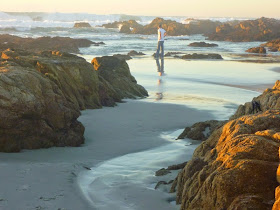 |
| Monarch butterfly next to Monarch Trail |
 |
| Monarch Boardwalk and seasonal pond in Eucalyptus Grove |
 |
| Monarch caterpillar illustration |
The boardwalk before you winds into a tree-filled canyon where thousands of monarch butterflies spend the winter each year. This sanctuary shelters the butterflies from chilly coastal winds, capture warmth from filtered sunlight and supplies nourishment to sustain them during their stay. The migratory monarchs are usually here during fall and winter months.
Follow the boardwalk to the viewing platform to discover what makes this a sanctuary that attracts people, monarch butterflies and other wildlife.
From the boardwalk you will get plenty of opportunities to zoom into butterfly anatomy. The wings of adult monarchs show tawny-orange patches separated by black veins. The black wing margin features small white spots. Not every butterfly with an orange-brown-black color palette is a monarch. The brown-and-black west coast lady and the red admiral are also common at Natural Bridges.
The Monarch Trail curves around the seasonal pond and then turns into a semi-perimeter trail of the eastern section of the park. Leaving the grove and pond behind, the trail passes through a small pine forest. The path turns left (north) near Delaware Avenue and crosses grassland and chaparral. At the T-junction in the chaparral area, you have the option of turning west and returning to the visitor center or of taking Moore Creek Trail straight ahead and hike downhill into a wetland area and to the lagoon next to the beach.
The visitor center provides—indoors and outdoors—a nice selection of educational exhibits about monarch butterflies, their metamorphosis, habitat requirements and migration pattern. The monarch butterfly is scientifically classified as a milkweed butterfly (subfamily Danainae in the family Nymphalidae). As the name indicates, butterflies of this subfamily depend on milkweed flora. They lay their eggs on milkweed plants. Monarch females place their eggs under milkweed leaves. The caterpillars and adults feed on milkweed, which contains poisonous substances. These cardenolides undermine the well-being of a predator after eating a monarch. Monarchs absorb the milkweed poison without being affected and so stay a better chance of survival since potential predators learn to avoid a diet of "poisoned monarchs." By closely inspecting the stems and leaves of the milkweed plants in the Demonstration Garden, you may be able to find eggs, caterpillars and chrysalides. You may catch a glimpse of the evolved stages of the monarch life cycle.
Populations of monarch butterflies tend to decrease and increase depending on weather patterns, logging activities and pesticide applications. The Xerces Society—commited to invertebrate conservation—frequently releases updates on the number fluctuations and changing states of Monarch populations [4].
 Getting there
Getting thereThe trailhead of Monarch Trail is located at the south side of the visitor center, across the Demonstration Garden with its various milkweed plants. See the section "Getting There" in my post "A multi-activity park in Santa Cruz: Natural Bridges State Beach" on how to get to Natural Bridges. The visitor building is in the center of the park, a short walk uphill from the beach. If you decide to drive into the park, you will find parking between the picnic area and the visitor center.
References and more to explore
[1] Let's Cruz: Monarch Magic at Natural Bridges State Beach [www.santacruz.org/blog/?p=3224].
[2] Sierra Club Trails: Natural Bridge [trails.sierraclub.org/trails/default.aspx?name=Natural_Bridge].
[3] EcoTopia: Natural Bridges State Park [http://ecotopia.org/trail/natural-bridges/].
[4] The Xerces Society [www.xerces.org]: Monarch Numbers Up Slightly, But Butterfly Still at Risk of Extinction. January 27, 2015 [www.xerces.org/2015/01/27/monarch-numbers-up-slightly-but-butterfly-still-at-risk-of-extinction/].






















